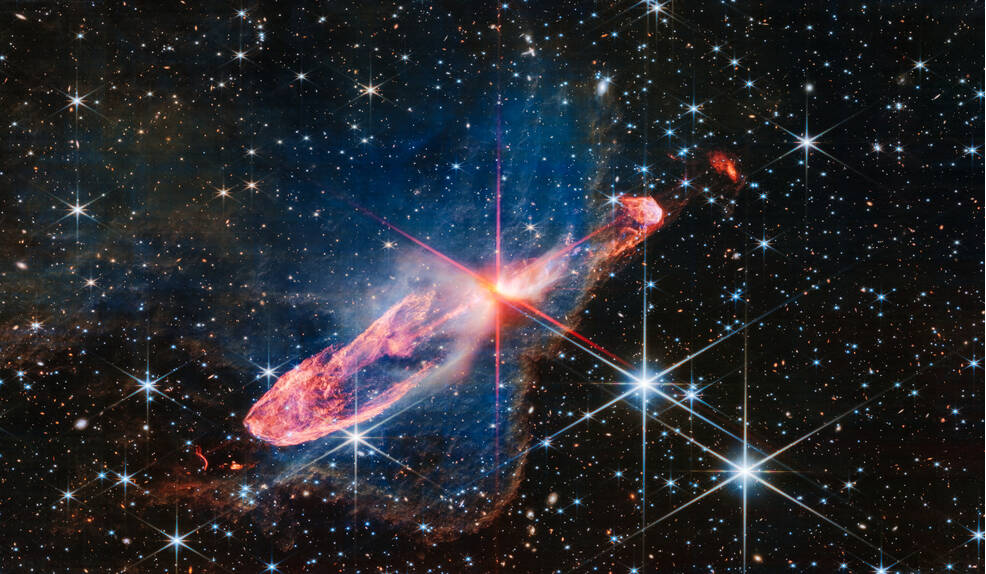The James Webb Space Telescope from NASA has captured the “antics” of a pair of actively forming young stars, called Herbig-Haro 46/47, in high-resolution near-infrared light.

NASA’s James Webb Space Telescope has captured a tightly bound pair of actively forming stars, known as Herbig-Haro 46/47, in high-resolution near-infrared light. Look for them at the center of the red diffraction spikes, appearing as an orange-white splotch. Herbig-Haro 46/47 is an important object to study because it is relatively young– only a few thousand years old. Star systems take millions of years to fully form. Targets like this give researchers insight into how much mass stars gather over time, potentially allowing them to model how our own Sun, which is a low-mass star, formed–along with its planetary system. Image Credit: NASA, ESA, CSA. Image Processing: Joseph DePasquale (STScI)
For them to be determined, it is possible to trace the bright pink and red diffraction spikes until one hits the center: The stars are inside the orange-white splotch. They are deeply buried in a disk of dust and gas that feeds their growth as they gain mass. The disk is not visible, but its shadow can be seen in the two dark and conical regions encircling the central stars.
The highly striking details are known to be the two-sided lobes that spread from the actively developing central stars, represented in fiery orange. The majority of this material was shot out from those stars as they repeatedly ingested and ejected the dust and gas that instantly encircled them over thousands of years.
When material from very recent ejections runs into older material, it alters the shape of such lobes.
This activity is like a great fountain being turned on and off in rapid, but random succession, resulting in a billowing pattern in the pool below it. Few jets emit more material, and others launch at faster speeds. Why? It is probably related to how much material fell onto the stars at a particular point in time.
The more recent ejections of the stars appear in a thread-like blue. They run just below the red horizontal diffraction spike at 2 o’clock. Ahead of the right side, such ejections make light wavy patterns.
They have been disconnected at points and end in an outstanding irregular light purple circle in the thickest orange area. Also, lighter blue, curly lines appear on the left, next to the central stars, but are sometimes obscured by the bright red diffraction spike.
All of these jets are vital to star formation itself. Ejections control how much mass the stars eventually collect. (The disk of gas and dust feeding the stars is small. Imagine a band tightly tied around the stars.)
The second most notable feature is the effervescent blue cloud. This is a region of dense gas and dust, known both as a nebula and, more formally, as a Bok globule.
When viewed primarily in visible light, it appears nearly completely black—just a few background stars peek through. In Webb’s crisp near-infrared image, one can see into and through the gauzy layers of this cloud, getting a lot more of Herbig-Haro 46/47 into focus while also showing a deep range of galaxies and stars that lie well outside of it.
The nebula’s edges show up in a soft orange outline, like a backward L along the right and bottom.
This nebula is considerable—its presence impacts the shape of the jets emitted by the central stars. As ejected material rams into the nebula on the lower left, there is more chance for the jets to mix with molecules within the nebula, leading them both to light up.
There are two other regions to look at to compare the asymmetry of the two lobes. Glance toward the upper right to distinguish a blobby, nearly sponge-shaped ejecta that seems split from the bigger lobe.
Just a few threads of semi-transparent wisps of material point toward the bigger lobe. Nearly transparent, tentacle-like shapes also show up drifting behind it, like streamers in a cosmic wind.
In the lower left, look beyond the hefty lobe to determine an arc. Both are made of material that was pushed the farthest and probably by earlier ejections. The arcs seem to be pointed in various directions and might have started from various outflows.
Even though it seems Webb has snapped Herbig-Haro 46/47 edge-on, one side is angled a little closer to Earth. Counterintuitively, it is the smaller right half. Though the left side is brighter and larger, it is pointing away.
Million years from now, the stars in Herbig-Haro 46/47 will completely form—clearing the scene of such fantastic, multi-hued ejections, thereby enabling the binary stars to take center stage.
Webb can show so much elaborately in Herbig-Haro 46/47 for two reasons. The object is comparatively close to Earth, and Webb’s image is composed of several exposures, which adds to its depth.
Herbig-Haro 46/47 is just under 1,470 light-years away in the Vela Constellation.